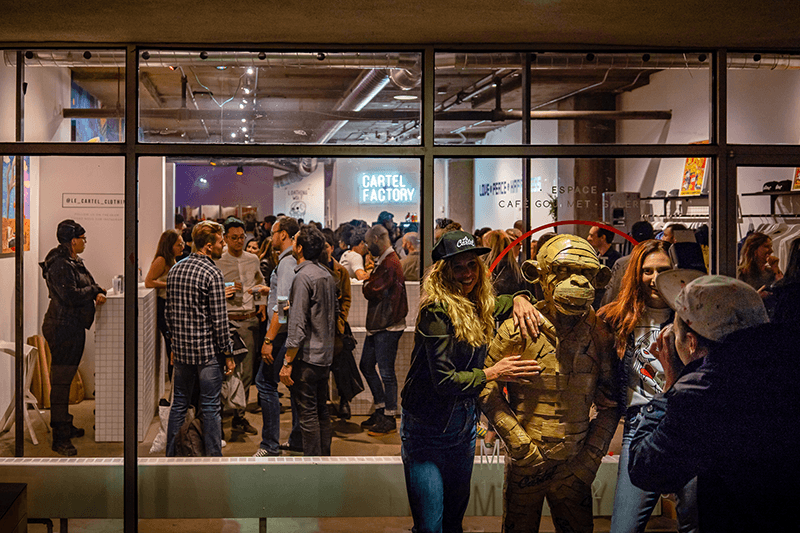Montreal-based clothing brand Le Cartel hosted its first gallery event at their brick and mortar store in the Mile End on Oct. 11. In addition to their Fall 2019 clothing line, the event had multiple DJ sets, a cocktail bar, and a flash tattoo station. The work of visual artists, such as William Houde, Aurelien Saly, and HRVB, were prominently featured on the walls, posters, t-shirts, and tattoos. Through all these forms, the event connected street art with streetwear as a style that permeates public space.
Founded in 2015, Le Cartel produces streetwear collections in collaboration with Montreal artists. Their past collections feature works from artists like illustrator KRUMP and muralist Monosourcil among many others. Their purpose as an organisation, according to their Instagram bio, is to explore the intersection between fashion and art. Le Cartel’s Fall 2019 collection features the intricate and groovy artwork of Epithumia Rose, a multidisciplinary artist known for her tattoo work, which she has practiced in studios across the world. Her designs feature on the backs of simple t-shirts, with the brand’s logo on the front. The art on these shirts is as sophisticated as that which would appear in a painting in a gallery.
While Le Cartel hosted the event, their clothes were hardly its focus: A throng of PBR drinking young professionals mingled near a dozen t-shirts hanging on the wall, but most patrons were there for other types of art that decorated spaces and bodies. A makeshift tattoo parlour in the corner of the room complemented the designs on both the t-shirts and on the walls.
Large graffiti pieces and duplicate posters by the German artist, HRVB, adorned the walls of the large event space. Originally from East Berlin, HRVB’s art is an homage to ‘90s rave culture, heavily influenced by the cultural and political climate that accompanied the fall of the Berlin Wall. Aptly titled ‘Berlin Calling,’ his work often includes pop culture characters like Mario and Lego figurines. As a nod to East Berlin’s history as a socialist state, these symbols of Western consumer culture are manipulated into high art, only to be plastered across buildings like advertisements. The format of the works themselves pertains to the setting of the street: Graffiti is often site-specific, whereas posters are designed to be reproduced and hung in a location of the owner’s choosing. Surprisingly, one of the highlights of the event was the bathroom stalls, where pop art style posters lined every inch of the walls; patrons could take these posters home with them as memorabilia. This process of art reproduction parallels streetwear itself: Taking artistic ideas from someone else on the street, and repurposing it in another space.
Street art, like graffiti and posters, is heavily informed by the space that it occupies. Similarly, streetwear has a sense of locality because it incorporates local influences and pop culture. While Le Cartel market themselves as the link between art and fashion, the art featured on the shirts is far more important than the garments’ construction. The fact that t-shirts are a staple of streetwear around the globe shows that the visual print design is essential to making an artistic statement, rather than the way it is worn. To some, it might seem excessive to pay so much for just a shirt or a hoodie but at least you know where that money’s going–directly into the pockets of Montreal artists. Streetwear like Le Cartel speaks to a city’s pride in its own artistic scene in the form of wearable art.








